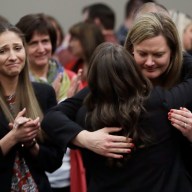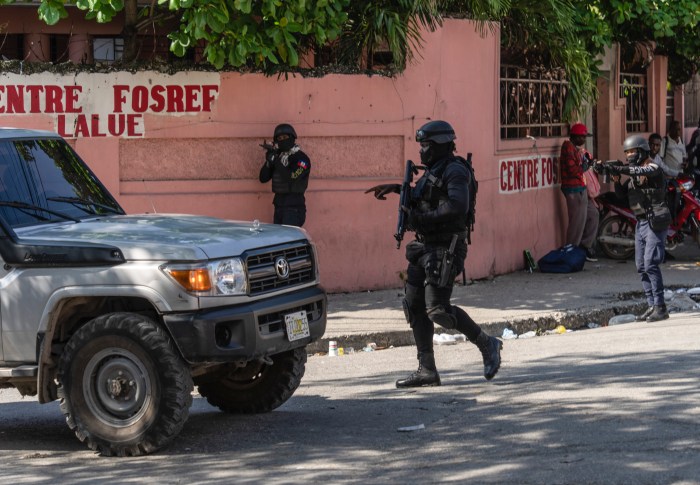KANDAHAR, Afghanistan – The explosion that killed three Afghan children last week was the work of the Taliban and not Canada’s fault, say military officials who admit they’re still struggling to understand the outburst of anti-Canadian sentiment touched off by the tragedy.
Forensic analysis of fragments from the bomb that killed the three young boys determined it was likely an old munition, perhaps left over from the Soviet occupation, that may have been fashioned into a booby trap, officials said.
Using old explosive material in a homemade bomb is a classic Taliban tactic, said Brig.-Gen. Jonathan Vance, the commander of Canadian soldiers in Afghanistan.
“The burden of proof and experience in this part of the province places the likelihood of harming people with explosives squarely on the shoulders of the insurgency, not on the shoulders of Canadians,” Vance said.
The children, aged 4, 12 and 13, likely found the device in a field on the way home from school and brought it into the village of Salehan, west of Kandahar city, before it detonated as they stood on a gravel pathway, he said in a prepared statement.
“The most likely cause of this explosion was an anti-personnel IED, based on all of the factors at the scene.”
Grief-stricken villagers paraded in the streets of Kandahar after the blast, displaying the shattered bodies of two of the victims and crying for vengeance against Canada.
A Panjwaii district elder claimed the blast was the result of an unexploded Canadian mortar the boys found while scavenging for scrap metal, a common – if perilous – source of revenue in dirt-poor Afghanistan.
Almost from the outset, Afghan police blamed the Taliban for the attack and theorized that the children had likely come across a booby trap that may have been meant for Canadian soldiers.
The fact villagers were eager to blame Canadians is troubling and difficult to explain, Vance conceded.
“Perhaps we can also muster some understanding as to why the initial reports and grief expressed by the families towards Canadian soldiers was sadly misplaced.”
The answer may lie in the fact that Salehan includes a separate community for the many local Afghans who have been left maimed and handicapped by years of living in the midst of armed conflict.
Canadian troops have conducted weekly range practice in the area, firing from heavy tanks and artillery in exercises that Vance defended Monday as both necessary and safe.
“It was a good spot to do a range,” he said. “The actual aiming point was far away from the village.”
For the military, such range exercises serve two purposes: they allow for training and target practice, but also serve to demonstrate the might of Canadian firepower in a region known as a transit point for Taliban fighters.
Vance did not address the question of whether it was appropriate to conduct live-fire exercises in such proximity to a group of people badly scarred by war, nor that of whether such practice could have bred simmering resentment.
He did acknowledge there had been complaints about the noise, and called it “a reasonable request” to move the range – something he intends to do.
There was no immediate reaction from Salehan to Monday’s news, which was delivered to Afghan media by Kandahar governor Tooryalai Wesa.
In spite of the fact coalition forces were not to blame, families of the dead and injured have already been compensated by Wesa, an Afghan-Canadian who has been on the job a scant few weeks.
Unlike the complex, litigious nature of the western approach to a wrongful death, the Pashtu culture is more straightforward. Whenever someone is killed, be it deliberately or accidentally, those responsible assume a debt obligation.
Each affected family was paid the rough equivalent of about $2,700 Cdn, since nothing would be forthcoming from either the Taliban or the long-departed Soviets, Panjwaii district leader Haji Baran said in an interview with The Canadian Press.
Indeed, it’s possible the anguished display of fiery anti-Canadian rhetoric was little more than a play for compensation in a society where children, no matter their age, are vital contributors to the family’s income.
“Those people have already lost a lot,” Baran said of the handicapped villagers. “Those kids were looking for metal to sell it, because they are so poor.”
The father of one of the victims lamented the loss of his eldest son, 13-year-old Sadar Mohammed, who was engaged to be married and intended to help support his family.
Ghazi Toor Jan, who is blind in one eye from a mine explosion during the Soviet occupation, said last week that his son was everything to him.
That grief, shared by the entire village, mingled with lingering frustration to create a highly volatile mix of emotions that erupted in last week’s gruesome display in Kandahar, Baran said.
Just a couple of months ago, Canadian development officials had made contact with the tiny hamlet, which is nestled near the soaring volcanic peak of Tur Ghar. They had hoped to make in-roads among notoriously suspicious locals.
Baran said the people believed the promises they heard and were generally impressed.
“These people like Canadians because they know Canadians.”
















